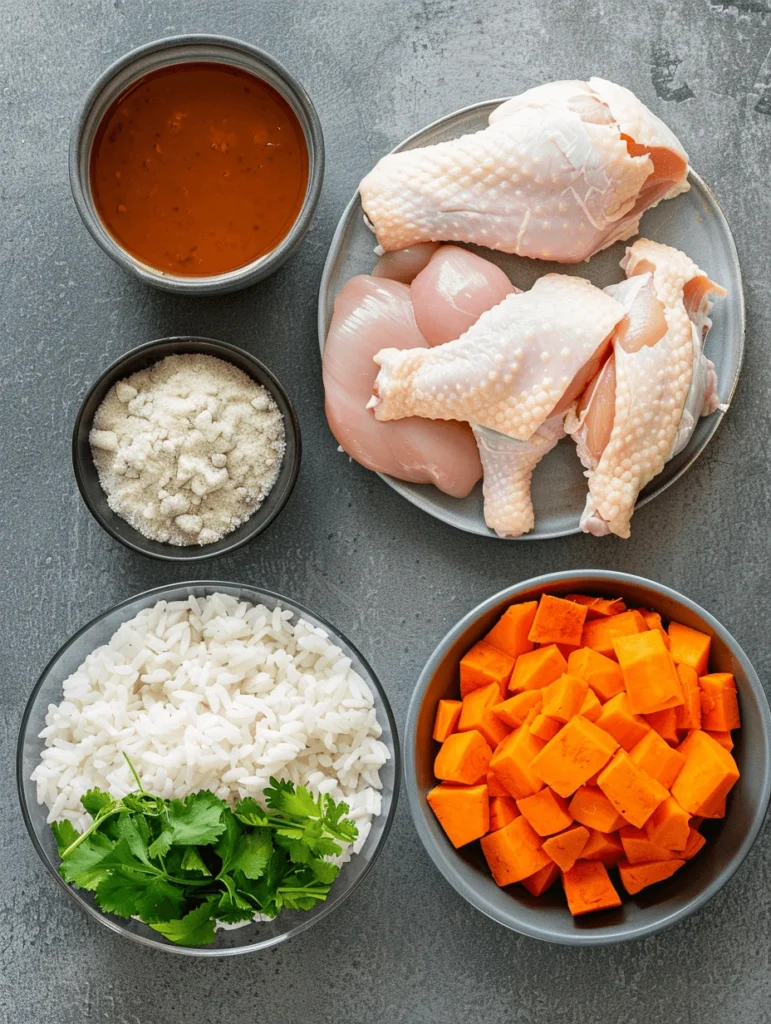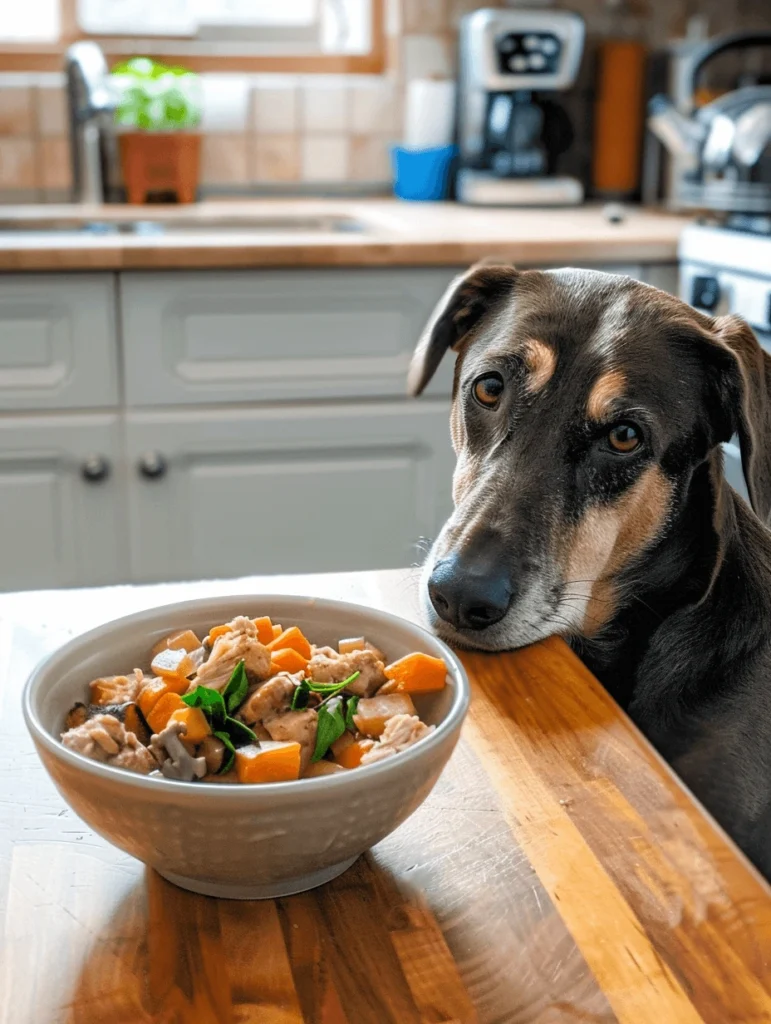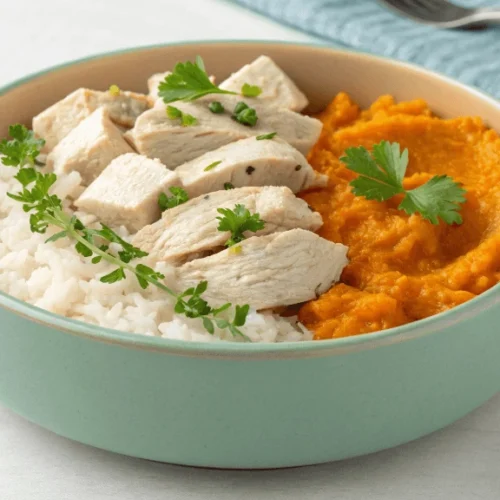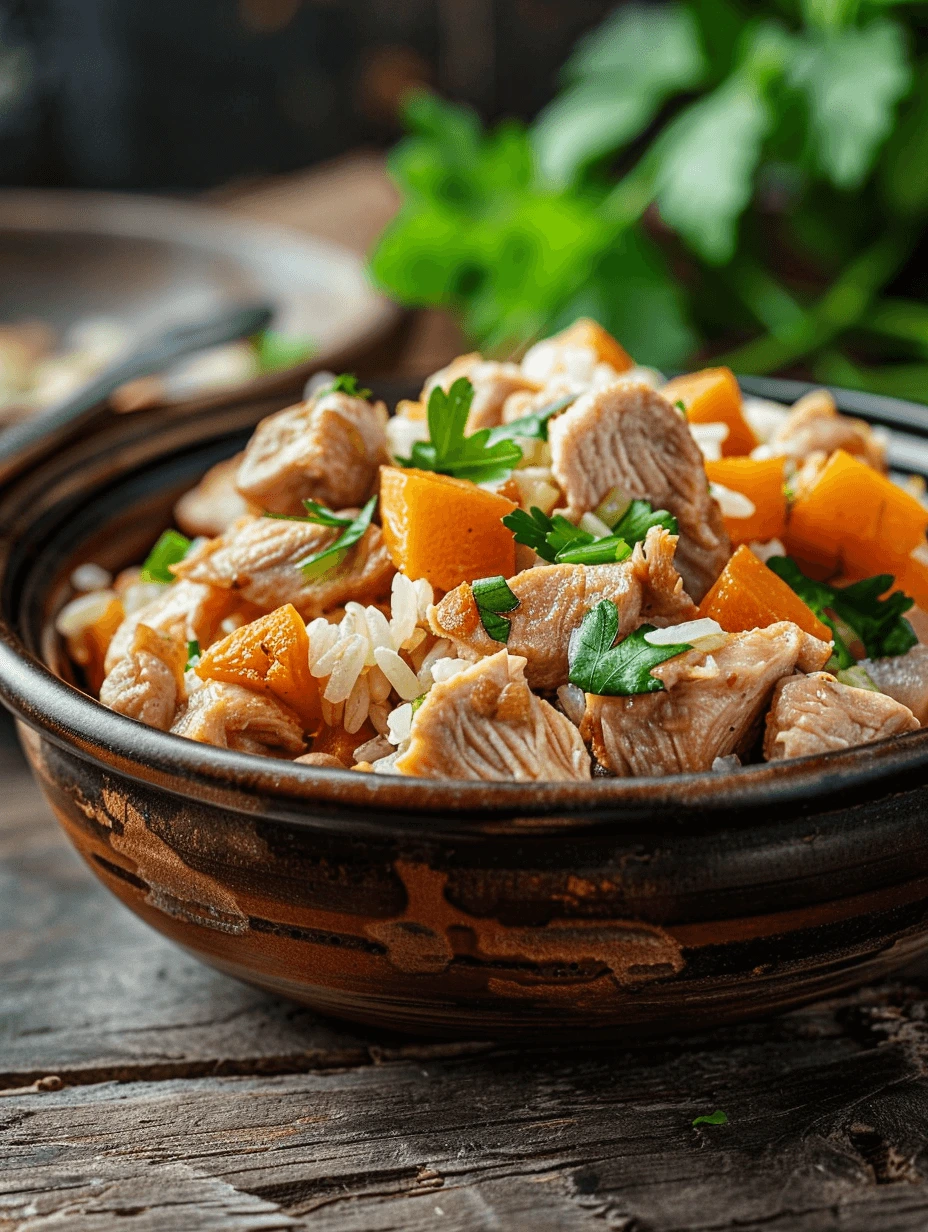When your furry friend has an upset tummy, refuses to eat, or just isn’t acting like themselves, it’s natural to worry. One of the safest ways to support your dog during recovery is by feeding them a bland dog food recipe. These gentle, easy-to-digest meals are often recommended by vets to help settle your dog’s stomach, ease digestion, and get them back on their paws—fast.
At Home Dog Recipes, we believe that even the simplest meals should be made with love, care, and your dog’s health in mind. In this guide, you’ll discover:
Table of Contents
Understanding the Need for a Bland Dog Food Recipe
What Is a Bland Diet for Dogs and When Should You Use It?
A bland dog food recipe is a simplified meal, typically made with a limited number of low-fat, gentle ingredients. These meals are designed to:
- Reduce digestive irritation
- Provide basic nutrition without overwhelming the system
- Help your dog regain appetite during illness or after surgery
Veterinarians usually recommend bland diets when dogs experience:
- Vomiting or diarrhea
- Gas or bloating
- Recovery from minor illness or surgery
- Transitioning back to solid food after a fast
The goal is to rest your dog’s digestive system while still providing nourishment. And the great news? You can prepare these meals safely at home using just a few pantry ingredients.
Common Signs Your Dog Might Need a Bland Diet
If your dog is showing one or more of the following symptoms, it may be time to consider a bland diet:
| Symptom | Why It Matters |
|---|---|
| Vomiting | Could indicate an irritated or inflamed stomach lining |
| Loose stools or diarrhea | Bland foods can slow down digestion and firm stools |
| Lethargy with no interest in food | A simple meal may tempt them to eat again |
| Post-surgery or antibiotic treatment | Helps rebuild gut flora without added stress |
Always check with your vet first. A bland diet is not a cure, but a supportive tool during mild tummy troubles or recovery. If your dog is showing signs of serious illness, dehydration, or worsening symptoms, seek immediate veterinary care.
Ingredients to Include in a Safe Bland Dog Food Recipe

Best Proteins for a Bland Diet (Chicken, Turkey, Scrambled Eggs)
Protein is an essential building block in your dog’s diet—even when they’re under the weather. But not all proteins are equal when it comes to soothing an upset stomach. The goal is to stick with lean, plain, and easily digestible options.
Here are the top safe protein choices for a bland dog food recipe:
| Protein Source | Why It’s Good | How to Prepare |
|---|---|---|
| Skinless Chicken Breast | Low-fat, gentle, and protein-rich | Boil or poach with no seasonings |
| Ground Turkey (lean) | Easier to chew, especially for smaller dogs | Cook thoroughly and drain any fat |
| Scrambled Eggs | Soft, easy-to-digest, rich in vitamins | Use water or a non-stick pan—skip butter or oil |
Are scrambled eggs considered bland food for dogs?
Yes! As long as they’re cooked plain with no seasoning, eggs can be an excellent protein source in a bland diet. They offer vital nutrients and are often well-tolerated, even when your dog is feeling off.
If your dog has food allergies or sensitivities, always check with your vet before introducing new proteins—even bland ones.
Gentle Carbs That Are Easy on Your Dog’s Stomach
In a bland dog food recipe, carbohydrates help restore energy and firm up stool without irritating your dog’s digestive system. Here are our top picks:
| Carb Source | Benefits | Preparation Tip |
|---|---|---|
| White Rice | Classic bland diet staple, easy to digest | Cook well and avoid over-seasoning |
| Boiled Potatoes (peeled) | Soft texture, easy to digest | Mash or dice, no butter or salt |
| Plain Pasta | Offers simple carbs for quick energy | Cook until soft and serve plain |
| Pumpkin Puree (plain) | Rich in fiber and easy on the gut | Use small amounts (no added sugar) |
What bland food should I feed my dog?
A simple mix of boiled chicken and white rice is often the gold standard. But dogs can also benefit from bland variations that include turkey, eggs, or even mashed potatoes—just remember to keep it plain and skip the seasonings.
Want to take it a step further? Discover great ideas like our pumpkin rice digestion bowl—a gentle twist on the traditional bland meal, especially helpful for dogs with diarrhea.
Vet-Approved Bland Dog Food Recipe (Step-by-Step)
Ingredients List with Natural and Safe Options
This basic bland dog food recipe uses vet-recommended ingredients that are gentle on the stomach, nutritious, and simple to prepare. It’s ideal for dogs recovering from diarrhea, vomiting, or minor gastrointestinal upset.
Basic Chicken and Rice Bland Diet Recipe (For 1-2 Meals)
| Ingredient | Amount | Notes |
|---|---|---|
| Boneless, skinless chicken breast | 1 cup, chopped | Boiled or poached, unseasoned |
| White rice | 1 cup, cooked | Fully cooked and soft |
| Water | As needed | Used for boiling |
| Optional: Pumpkin puree (plain) | 1 tablespoon | Helps with digestion |
Important: No salt, oil, garlic, onions, or seasonings of any kind.
This recipe is crafted to be 100% natural, safe, and simple—just like all the recipes at Home Dog Recipes. We never use additives or preservatives.
Cooking Instructions for Preparing a Basic Chicken and Rice Recipe
Follow this easy, step-by-step method to make your dog’s bland meal:
- Boil the Chicken
Place the chicken breast in a pot, cover with water, and bring to a boil. Let it cook thoroughly (about 15-20 minutes). Ensure there’s no pink inside. - Cook the White Rice
In a separate pot, cook plain white rice using a 2:1 water-to-rice ratio. Do not add butter, oil, or salt. Let it cool completely. - Mix and Serve
Chop or shred the cooked chicken into bite-sized pieces. Combine with the rice at a 1:2 ratio (1 part chicken to 2 parts rice). Add a tablespoon of plain pumpkin puree for extra fiber if needed. - Cool Before Serving
Always let the meal cool to room temperature before feeding your dog. Serve in small portions to monitor tolerance.
Pro Tip: Store leftovers in an airtight container in the fridge for up to 3 days. You can also freeze in small meal-size batches.
Is chicken and rice a bland diet for dogs?
Yes! This is the most common and vet-recommended bland dog food recipe. It’s safe, soothing, and easy to prepare at home.
Can you give dogs scrambled eggs?
Absolutely. Scrambled eggs—cooked without butter or seasoning—are a fantastic protein alternative if your dog isn’t a fan of chicken.
Need an alternate protein option? Check out our turkey and rice bland meal recipe for a gentle variation dogs love.
Bland Dog Food Recipe Variations

Recipe with Turkey and Sweet Potatoes
For dogs who don’t do well with chicken or simply need a protein change, lean ground turkey is a fantastic substitute. Combined with fiber-rich sweet potatoes, this variation is soft, digestible, and naturally flavorful—without any added seasonings.
Turkey & Sweet Potato Bland Dog Food Recipe
| Ingredient | Amount | Notes |
|---|---|---|
| Lean ground turkey | 1 cup | Cook thoroughly, drain excess fat |
| Sweet potato (peeled) | 1 cup, mashed | Boiled or steamed until very soft |
| Water | As needed | Use during cooking only—no broth or flavorings |
Preparation:
- In a skillet, cook ground turkey on medium heat until no longer pink.
- Boil or steam sweet potatoes until fully soft, then mash them with a fork.
- Combine the turkey and sweet potato in a 1:2 ratio (1 part turkey to 2 parts sweet potato).
- Cool to room temperature before serving.
This blend is gentle and filling—great for easing your dog back into eating while also providing a wholesome meal.
Don’t miss our dog-safe sweet potato chew recipe—a tummy-friendly treat that supports digestion.
Vegetarian Bland Diet Recipe Using Pumpkin and Rice
Some dogs experience protein intolerance, or you may want a meatless meal option during recovery. This vegetarian bland recipe is gentle, hydrating, and full of fiber—perfect for mild digestive upset.
Pumpkin & Rice Meatless Dog Meal
| Ingredient | Amount | Notes |
|---|---|---|
| Plain pumpkin puree | 1/2 cup | Use unsweetened, no spices |
| Cooked white rice | 1 cup | Fully cooked, no seasoning |
| Banana (optional) | 1/4 banana, mashed | Adds soft texture and potassium |
| Water | 2–3 tablespoons | Helps with mixing and hydration |
Preparation:
- Mix cooled, cooked white rice with pumpkin puree.
- Optionally mash in a little banana for taste and added nutrients.
- Add water as needed for consistency. Serve cool and fresh.
Why it works: Pumpkin is high in soluble fiber, helping to firm up stools, while rice provides gentle energy. Banana offers potassium—a mineral often lost during diarrhea or vomiting.
Looking for something extra mild? Try our pumpkin banana belly soother.
Feeding Guide and Portion Tips for bland dog food recipe
How Much Bland Food Should You Feed Your Dog?
When your dog is recovering from an upset stomach, portion control becomes just as important as the ingredients you use. The goal is to ease digestion—so feeding smaller, more frequent meals is key.
Here’s a general guideline based on your dog’s weight:
| Dog’s Weight | Meal Size (Per Meal) | Frequency |
|---|---|---|
| Under 10 lbs | 1/4 to 1/2 cup | 3–4 meals/day |
| 10–25 lbs | 1/2 to 1 cup | 3–4 meals/day |
| 25–50 lbs | 1–1.5 cups | 2–3 meals/day |
| 50+ lbs | 1.5–2.5 cups | 2–3 meals/day |
Note: These are general estimates. Always monitor your dog’s condition and consult your vet for personalized advice.
To avoid overfeeding, watch for signs like bloating, vomiting, or lethargy after meals. If any of these occur, reduce the portion size and increase time between meals.
Looking for inspiration? Try our dog food portion calculator to tailor feeding amounts based on age, weight, and activity level.
How Often to Feed and When to Transition Back to Regular Food
A bland diet is not meant to be permanent. Once your dog’s symptoms improve—typically after 2 to 5 days—you can slowly begin reintroducing their regular diet.
Transition Timeline:
- Day 1: 75% bland food + 25% regular food
- Day 2: 50% bland food + 50% regular food
- Day 3: 25% bland food + 75% regular food
- Day 4: 100% regular food
Monitor stool consistency, energy levels, and appetite during this phase. If symptoms return, go back to the bland diet and consult your vet.
Don’t rush it. The digestive system needs time to readjust. A slow transition helps prevent relapse.
For sensitive pups, it may help to shift permanently to a gentler everyday diet. Check out our everyday easy-digest dog meals for long-term solutions.
Adding Nutrition to Bland Diets Safely

Nutritional Supplements and Add-Ins Your Vet Might Recommend
While a bland diet is purposefully plain, that doesn’t mean it has to lack essential nutrients—especially if your dog is on it for more than a few days. With your vet’s approval, you can safely add gentle, natural enhancements that support healing and restore balance.
Here are some vet-recommended, tummy-friendly additions:
| Add-In | Purpose | Usage |
|---|---|---|
| Plain canned pumpkin | Adds fiber to firm stools | 1–2 tsp per 10 lbs of body weight |
| Bone broth (low sodium) | Provides hydration, minerals, and flavor | 1–2 tbsp per meal |
| Dog-safe probiotics | Supports gut health and immune system | Vet-recommended dosage only |
| Slippery elm powder | Natural soothing agent for the digestive tract | 1/4 tsp mixed in food |
| Boiled carrots or peas | Gentle fiber, vitamins, and texture | Mash and mix sparingly (not raw) |
Important: Always consult your veterinarian before adding supplements, especially if your dog has ongoing symptoms or is on medication.
Learn more about safe supplements for dogs with sensitive stomachs—our detailed guide helps you choose what’s best for your pup.
Safe Herbs or Flavors That Won’t Upset Your Dog’s Tummy
While you want to avoid anything spicy or heavily flavored, there are a few natural herbs and subtle enhancements that can safely be added to bland dog food for a mild flavor boost and added health benefits.
Dog-Safe Flavor Boosters:
| Ingredient | Benefit | Tip |
|---|---|---|
| Parsley (fresh, finely chopped) | Freshens breath, mild digestion support | Use sparingly—1/8 tsp per meal |
| Ginger (tiny pinch) | Anti-nausea and digestion support | Only if vet-approved |
| Mint (fresh leaves) | Soothes digestion, freshens breath | Very small quantities only |
| Bone broth ice cubes | Adds flavor and hydration | Pour into food bowl to soften meals |
Avoid salt, pepper, garlic, onions, and oils—they are harmful to dogs even in small amounts.
If your pup is a picky eater, a splash of homemade bone broth or a soft mash of sweet potato can do wonders for appeal and nutrition—without risking GI upset.
Discover great ideas like our herbal dog broth booster recipe—a gentle way to bring meals back to life!
Common Mistakes to Avoid with Bland Dog Food Recipe
Why You Should Avoid Seasonings, Oils, and Raw Food During Recovery
Even the most well-meaning pet parents can unintentionally cause setbacks by adding ingredients that don’t belong in a bland diet. While we all want to make meals more appealing for our pups, it’s important to remember that simplicity is key when your dog is healing.
Ingredients to Avoid:
| Ingredient | Why It’s Harmful |
|---|---|
| Salt, garlic, onions | Toxic to dogs and can cause anemia or GI upset |
| Butter, oils, or fats | May worsen diarrhea or cause pancreatitis |
| Raw meat or eggs | Harder to digest and risky during illness |
| Broth with seasoning | Often contains sodium, garlic, or onion powder |
| Spicy herbs or sauces | Irritate the stomach and disrupt healing |
A bland dog food recipe must stay true to its name—no flavors, sauces, or seasoning should be added unless specifically approved by your vet.
Even small “treats” or table scraps during recovery can undo all your hard work.
Recognizing When Bland Food Isn’t Working and Calling Your Vet
Bland food is a short-term solution, not a long-term fix. It’s designed to soothe the stomach, not treat underlying illness. If your dog isn’t showing improvement, you might need more than just a change in diet.
Call your vet immediately if you notice:
- Persistent vomiting or diarrhea after 48 hours
- Refusal to eat or drink
- Bloody stools
- Lethargy or sudden behavior changes
- Dehydration (dry gums, sunken eyes, skin that stays lifted after pinching)
A bland dog food recipe is helpful, but it’s not a substitute for professional medical care. Always monitor your pup closely.
If you’re unsure, don’t guess—consult your veterinarian.
For long-term support, consider transitioning your dog to a gentle, easy-digest daily meal plan. Don’t miss our 7-day sensitive stomach meal plan for dogs to help your pup thrive after recovery.
Tips for Making Bland Dog Food Recipe More Appealing
Texture Tricks for Picky Eaters
When your dog’s appetite dips, texture matters just as much as flavor. Soft, moist, and familiar consistencies can encourage eating, especially in dogs with nausea or anxiety around food.
Here are some simple and safe texture-enhancing tricks:
| Tip | Why It Helps |
|---|---|
| Shred the protein finely | Makes it easier to chew and swallow |
| Mash ingredients together | Creates a unified, pudding-like texture some dogs prefer |
| Add a spoonful of warm water or broth | Moistens dry rice and enhances aroma |
| Serve slightly warm | Increases scent, which can stimulate appetite |
| Hand-feed or offer small bites | Builds trust and helps with picky or anxious dogs |
Avoid serving food straight from the fridge. Always let meals cool to room temperature or gently warm them—never microwave directly, as this can cause hot spots and destroy nutrients.
How to Warm or Serve Meals to Boost Appetite Naturally
Even though bland diets are plain, a little care in presentation can go a long way. Warming food safely can trigger your dog’s sense of smell, which is vital to appetite.
Safe Serving Enhancements:
- Use warm (not hot) water to loosen up dry rice and soften protein.
- Mix in a tablespoon of homemade low-sodium bone broth for gentle flavor.
- Try freezing meal portions into silicone molds and defrosting just before feeding for variety.
- Use dog-safe feeding puzzles to make bland meals feel like a treat or game.
If your pup really struggles to eat, you can also try feeding with a spoon or gently offering small bites by hand. This close interaction helps nervous dogs feel reassured.
Need extra help with picky pups? Check out our top feeding hacks for finicky dogs—especially useful when dealing with digestive issues.
How Homemade Bland Diets Compare to Store-Bought Options
Pros and Cons of Homemade vs. Commercial Bland Foods
When your dog is feeling unwell, choosing between a homemade bland dog food recipe and a commercial bland diet can feel overwhelming. Both have their place—but depending on your dog’s needs and your values, one may fit better than the other.
Here’s how they compare:
| Aspect | Homemade Bland Food | Store-Bought Bland Food |
|---|---|---|
| Ingredients Control | Full control—only what you add | Often vague labels, may contain preservatives |
| Cost | Usually cheaper (especially long-term) | Can be expensive, especially vet-prescribed |
| Convenience | Requires time to cook and prepare | Ready-to-serve options available |
| Freshness | 100% fresh and preservative-free | Often processed for shelf life |
| Customization | Easily tailored to your dog’s sensitivity | Limited to pre-formulated options |
| Transparency | Clear—you’re making it yourself | May require deep label research |
Homemade recipes align perfectly with our core values at Home Dog Recipes: love, health, and transparency. You know exactly what goes into each meal—and you can adjust ingredients based on your dog’s recovery.
However, store-bought bland diets—especially those prescribed by a vet—can be a useful stopgap if you’re short on time, traveling, or need precise nutrient formulas for a medical condition.
When It’s Okay to Use Vet-Prescribed Commercial Alternatives
Sometimes, your vet may recommend a specific commercial bland food—often for cases like:
- Chronic digestive issues or pancreatitis
- Food allergies or prescription-only needs
- Recovery after surgery or hospitalization
- Very young puppies or senior dogs needing complete, balanced formulas
If this is the case, don’t worry—you’re not compromising. Just be sure to check for:
- No added artificial colors, preservatives, or flavorings
- Clear ingredient labeling
- Easily digestible protein and carb sources (e.g., turkey, rice, potatoes)
In any case, make the choice that fits your dog’s current condition and your lifestyle.
If you’re looking to return to fresh, home-prepped meals after commercial food, we’ve got you covered. Don’t miss our reintroduction plan from kibble to homemade food to help ease the transition safely.
Supporting Your Dog’s Health Through Gentle Nutrition
When your dog isn’t feeling their best, it’s hard not to worry. But with the right approach, a bland dog food recipe can be one of the most loving and effective ways to support their healing. From gentle proteins like chicken and turkey to soothing carbs like rice and pumpkin, homemade bland meals give you full control over what your dog eats—without the risks of additives or preservatives.
At Home Dog Recipes, we believe that food is love. That’s why every recipe we share is made with care, transparency, and your dog’s well-being in mind. Whether your pup needs a few days of recovery or long-term digestive support, you have the power to nourish them naturally and safely.
Stay patient, observe closely, and consult your vet when needed. Most importantly, trust that your care—backed by simple, homemade meals—makes all the difference.

Bland Dog Food Recipe
Ingredients
1 cup boneless, skinless chicken breast (boiled and shredded)
1 cup cooked white rice (unseasoned)
1 tbsp plain pumpkin puree (optional – aids digestion)
Water (as needed for boiling)
Instructions
- Boil the chicken: Place the chicken breast in a pot, cover with water, and boil for 15–20 minutes until fully cooked. Shred into small pieces.
- Cook the rice: In a separate pot, cook white rice using a 2:1 water-to-rice ratio. Let it cook until soft and fluffy.
- Combine: Mix chicken and rice in a 1:2 ratio (1 part chicken to 2 parts rice). Add 1 tbsp pumpkin puree if using.
- Cool before serving: Allow the mixture to cool to room temperature before feeding.
- Serve small portions: Feed in 2–3 small meals per day based on your dog’s size and condition.
Notes
- Storage: Store leftovers in an airtight container in the fridge for up to 3 days.
- Freezing Tip: Portion and freeze for up to 1 month. Defrost fully before serving.
- Vet-Approved: Always check with your vet before starting a bland diet, especially for chronic symptoms.

1 thought on “Bland Dog Food Recipe – The Best Vet-Approved Homemade Meals (Top 6)”